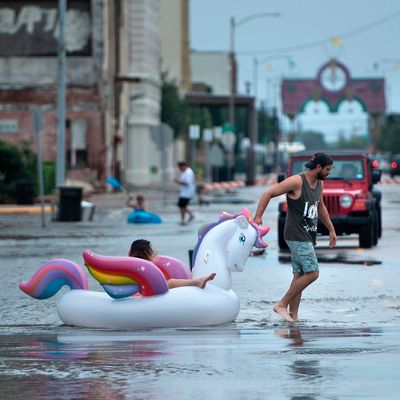
Hurricane Harvey touched down in Texas last Friday and has been wreaking havoc ever since. Eight people have died and parts of the state are experiencing some of the worst flooding in United States history. Online, reaction and response to the storm have been equally messy. Hoaxes. Misinformation. General chaos. To help guide you through it, here are Select All’s ten best practices for using social media, or rather using it wisely, during a crisis.
1. Call 911, not Facebook, if you need emergency help — and stay on the line.
The Coast Guard is asking that people in Texas who are in distress not post on social media. Instead, people should call 911 and stay on the line, or keep calling until they get through.
2. Don’t blindly retweet photos, rumors, or suspiciously perfect news stories.
No, Barack Obama didn’t spend his weekend serving food to those affected by Harvey. But if you happened to see a now-deleted viral tweet featuring a photo of him — taken in Texas back in 2015 when the Obama family volunteered at a homeless shelter — you might have thought he did. (Obama’s long-sleeved sweater might have been a tip the photo wasn’t taken during a Texas summer.) If something seems too good to be true — or too bad to be true — it probably is. Be your own fact-checker and do some homework before you spread information.
3. Don’t co-opt the hashtag.
Hashtags are a great way to label and track information during a crisis. But the people using #HurricaneHarvey to find resources and news shouldn’t have to filter through your “good vibes and prayers” tweets to get that info, no matter how well-intentioned your vibes are.
4. While you’re at it, spell the hashtag correctly.
It’s Harvey. Not Harvery.
5. Follow verified accounts to ensure you’re getting and sharing news from journalists, not virality-seeking hoaxers.
If you’re looking to find accurate information and breaking updates, following verified news outlets, government organizations, and local reporters on the ground is a safe way to go.
6. When you’ve found verified problems, signal boost.
Once you’ve verified that the information in the tweet you’re reading is accurate, retweet with abandon. Residents of a senior center in Dickinson, Texas, were rescued over the weekend after images of them sitting in waist-deep water went viral on Twitter.
7. Don’t create hoaxes.
Don’t be the dick adding more fear and panic to an already dangerous situation. People have died. Many are still in harm’s way. Skip the Photoshopped picture of a shark floating down a freeway. The retweets aren’t worth it, and the gag is so old, it’s not even funny anymore.
8. Shut down hoaxes when you see them.
Call people on their shit. If it’s a friend you see tweeting misinformation, slide into their DMs and kindly correct their mistakes. If it’s somebody acting more maliciously, shame them. Enough people called out the “Obama homeless shelter” tweet that it was eventually deleted.
9. Put your money — or your time, or your blood — where your mouth is, and let other people know where and how.
Thoughts and prayers are nice, but performative concern isn’t going to actually aid anybody in need. Instead, here are a few Harvey-specific places and ways you can help. If you’re looking for information to signal boost, this is among the most valuable.
10. Use your massive Twitter platform to do more than just marvel at the size of the disaster.
Actually, this one mostly just applies if you’re president.





























